

 Vol. 39 (# 10) Year 2018. Page 36
Vol. 39 (# 10) Year 2018. Page 36
Rafael SANTOS 1; Sam DEVINCENZI 2; Silvia BOTELHO 3; Marcos BICHET 4
Received: 12/09/2017 • Approved: 02/11/2017
4. Implementation aspects and prototype integration
6. Conclusions and future work
ABSTRACT: Cyber-Physical Systems (CPS) are integrations of computational systems with physical world processes. There are some challenges to be solved in CPS, such as its use in education. This paper presents an model to taking into consideration the concerns related to the integration of physical environments with virtual learning environments. First, the paper presents a definition and characterization of a Educational Cyber Physical Systems, proposing a conceptual model for their development. We have developed a prototype that implement ECPS. |
RESUMEN: Los sistemas Cyber-físicos (CPS) son integraciones de sistemas computacionales con procesos físicos del mundo. Hay algunos desafíos a resolver en CPS, tales como su uso en la educación. En este trabajo se presenta un modelo a tener en cuenta las preocupaciones relacionadas con la integración de entornos físicos con entornos de aprendizaje virtual. En primer lugar, el trabajo presenta una definición y caracterización de un sistema educativo cibernético-físico, proponiendo un modelo conceptual para su desarrollo. Hemos desarrollado un prototipo que implementa PAE. |
In recent years, studies have sought to unite two worlds that existed only separately. Cyber-Physical Systems (CPS) proposals begin to appear, trying to integrate computer systems with the physical world objects [11].
In this new context, it has become constant the discussion about technology impacts in the school environment. Studies of Information and Communication Technologies (ICTs) in education establish new areas of research, such as e-learning [4], distance education [15], virtual learning environments [5], mobile learning (m-learning) [9], ubiquitous learning (u-learning) [7], etc.
E-learning is a broad term that generally encompasses other terms associated with the use of ICTs in education and is defined by [8] as the provision of education (all activities relevant to instruct, teach and learn ), through electronic communication/digital, such as the Internet, intranets, satellite TV, video, audio, CD, DVD, etc.
Advances in e-learning produced a series of new teaching materials that use multimedia resources in the teaching-learning process. In this context, learning objects began to gain strength. These resources may include videos, images, animations, simulations, hypertext, presentation slides, among others. The use of these objects became common with the advent of distance education mediated by ICT, educational process where teachers and students are separated spatially and/or temporally [13].
From the concept of virtual learning communities, arise the first Virtual Learning Environments (VLE). [5] identifies VLE by a number of characteristics, such as being a social space and to design information, be a place where students co-construct the virtual space, be a space that is not restricted to distance education, but also with activity classroom, among others [5]. These environments often provide a number of learning objects, and they also have tools for communication between students and teachers.
In this sense, this paper is based on a large main theme: Technology Enhanced Learning, which is characterized as any technological system that directly supports the learning and teaching. This thematic area has foundation in education and computing, which will be explored through virtual learning environments and human-computer interfaces used in cyber-physical environments. In this work, a study of virtual learning environments will be presented, with the term understood it in a more restricted form sometimes (institutional VLE), and other times more generally (as Technology Enhanced Learning).
This paper presents the issues related to integration of physical environments with virtual learning environments which become the focus of this work, by proposing a Educational Cyber Physical Systems (ECPS). It is believed that the technological advances of recent decades has enabled the creation of advanced human-computer interfaces capable of providing such integration. Following, the Toogle platform, which is designed to implement cyber-physical systems will also be described. The platform was built to allow the creation and editing of environments that integrate physical and virtual worlds, and also to provide user navigation by these environments.
This paper is organized as follows: Chapter 2 analyzes the related works and the challenges in CPS. Then, the proposal for a Educational Cyber Physical Systems (ECPS), is presented in Chapter 3, while in the Chapter 4, are presented and discussed the implementation aspect and prototype integration. Finally, Chapter 5 presents the work evaluation.
Among the new Human-Computer Interfaces that have emerged in recent times, we highlight the Cyber-Physical Systems (CPS), which are integrations of computer systems with physical processes [11]. For [11] in CPS:
"Embedded computers and networks monitor and control the physical processes periodically, where physical processes affect the computer and vice versa. In the physical world, the passage of time is inexorable and concurrency is intrinsic. None of these properties is present today in computing or network abstractions."
A CPS adds computing resources, communication and storage to monitor and control the physical world entities, reliable, safe, efficient and in real time [18].
In the physical world, a central property of a system is its dynamics, your progress over time. In the virtual world, the dynamics is reduced to state changes sequences without temporal semantics. It is intended with CPS allow this integration by studying the joint dynamics of physical processes, software and networks.
A CPS consists of three basic elements: real space, presents objects from physical environment, like cars, people, houses, etc; object domain, consists of sensors/actuators (or devices equipped with sensors/actuators) connected by network; cyber/Virtual space, is formed when the object's domain provides the physical sensing and also to act in the objects domain.
In this section related works will be displayed about the two main issues involved in this work: the Cyber-Physical Systems and Virtual Learning Environments.
As for educational proposals involving physical and cyber systems, the working of [14] aims to investigate the effect of experience with understanding of concepts related to light and colors, through physical objects and virtual objects. For the assessment of student learning, protocols with well-defined questionnaires and procedures were used and the results showed that the use of a mixed combination of physical and virtual objects provided a more advanced understanding by undergraduate students compared with the use of objects alone.
Although the proposed of [14] involves a high degree of interaction with objects (physical), trade opportunities between the learners do not seem to be exploited. With regard to technological aspects, the proposal uses only virtual environments for manipulation of virtual objects, losing the ability to integrate information from the physical world to be used by the virtual world.
The paper is very well founded, bringing good review of studies that address the educational use of concrete and virtual materials in teaching and discussing the importance of integrating these objects in the curriculum of some disciplines, such as physics. On the other hand, the text don't explores the possibilities of collaboration between students during the experiments with virtual and physical objects and does not report about authoring tools.
Among the benefits presented in the work, one can identify a good student engagement as it proposes the use of physical elements of the real world and virtual elements, and their good usability and multi-sensory approach, as it allows the manipulation of objects physical, working touch, vision, motor skills, etc.
Other work which involves the use of Cyber-Physical Systems in education is [12], which describes the development of an intelligent laboratory, constructed through CPS, using as an example the thermal comfort and safety as environmental regulatory factor. The CPS was validated in an engineering laboratory of a university with 150 students.
The experiment used a base station with algorithm that interacted with measurement sensors and actuators in order to analyze, interpret and act on the environment and adjusting it appropriately.
Defined the purpose of the CPS, students had the challenge to develop engineering machinery to control abnormal situations designed, as an exercise for practical application of the theory studied.
The scenario of experiments was designed to control the temperature and humidity laboratory. At one point a hot steam source was placed near a sensor to simulate the changing environmental levels for hot and humid, and the students' solution had to detect and act on this change, powering the electric actuator of fan to provide adequate air ventilation for regulating the levels in the environment.
Reviewing the work presented, it is possible to identify the approach as a good educational solution in levels of interactivity, authoring ability, engagement, multisensory use and technology to achieve a degree of "intelligence". On the other hand, the CPS as a learning environment does not include pedagogical approach, nor specific tools for administration and/or evaluation of activities, being external to the scope of application the presence of such characteristics.
As we have shown, there are several possibilities with the development of cyber-physical systems (CPS), however [11] points out that the economic and social potential of these systems is still much higher than what has been accomplished and that large investments are being made around the world in the development of such technologies.
The first major challenge is the high initial cost for universities and schools to invest in equipment to enable them to 'join' the emergence of the next generation or future Internet [3]. Although they are not formally known as Internet, these future Internets are designed to be radically different from the current Internet in the way they work and in terms of gigabit capabilities exchange. The high cost initially highlighted is that these institutions can have access to these ultra high gigabit networks.
Give attention to safety during the operation of equipment in the physical environment for educational activities is a major challenge in the development of CPS. When students access physical systems from remote or distributed locations, it is essential to have a well-developed security system, which is integrated in the cyber physical realm. The role of sensors and control and security modules becomes important in dealing with such unexpected situations, avoiding accidents and incidents [3].
It will require new abstractions that allow group and manage a heterogeneous mix of sensors and actuators from various networks and domains. CPS can be highly dynamic in nature, when related to its physical processes and computing resources [3]. The challenge here is related to the scenario in which the physical world is not entirely predictable and therefore CPS will not be operating in a controlled environment, and should be robust to unexpected conditions and adaptable failures of the subsystem [11].
After the characteristics presented and examples of VLE in Chapter 2, in the previous section, a draft platform for implementation of physical and cyber systems, the aim is now examining the possibility of integrating such elements (real and virtual), in educational settings . Therefore, we present the proposed Educacional Cyber Physical Systems (ECPS), first looking to expose their requirements, their definitions and characteristics. After, we discuss about a conceptual model for ECPS and their educational approaches. Finally, we seek to verify the necessary adaptations for implementing a ECPS through Toogle platform.
Based on the study of related works [3] is proposed that a ECPS must meet the requirements described below. Communication and interaction: must provide communication and interaction between learners and teachers, enabling collaborative learning. Administrative Tools: must have administrative tools for the learning management. Assessment tools: must have tool by which you can track students' learning levels. Pedagogical Approach: should allow the development of students from different educational guidelines. Authoring tools: must have tools by which students are able to create, according to their context and their experiences. Intelligence: should provide some level of intelligence to the aid of learning. Engagement: should provide students experience with high level of participation and that directly affect their development, producing effective learning. Multisensory approach: should be able to integrate multisensory information from environments such as sounds, videos, texts, 3D animations, etc.
From the raised requirements, it is proposed feature and concepts of an ECPS.
A physical-virtual learning environment has the seven characteristics of a VLE, presented by [5]. A ECPS stands out especially have characteristics that differ from VLE: The virtual space is present in different real spaces.
According to this new feature, the physical and virtual learning environments should provide that physical spaces contemplate various elements of the virtual world and vice versa. Moreover, as the student moves through the different physical spaces of your day-to-day, a ECPS should allow this to experience educational spaces during such times, using, for this, the physical elements of local and elements virtual.
Therefore, a ECPS should make use of real/physical elements (such as global positioning information, groups with which has been in activities conducted, for example) to contextualize student learning across different physical spaces in which it acts, and virtual elements (such as images, videos, animations, etc.). Thus, it is intended that a ECPS can provide a high degree of student engagement, becoming part of your day-to-day.
Seeking to highlight the features of Cyber-Physical Systems in education, [3] presents five essential components of a ECPS:
Fig. 1
Conceptual Model for a ECPS (adapted from [6])
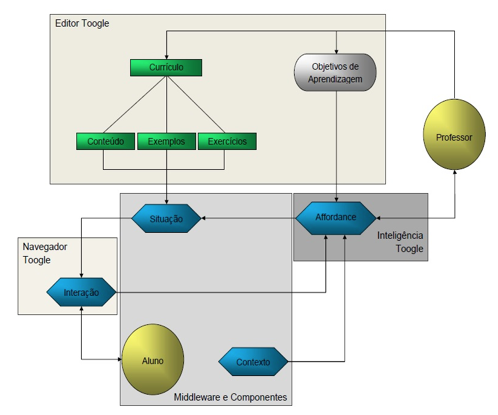
In order to define a terminology that specifies the concepts involved in a educational cyber physical systems, this work of the suggested model for VLE [6]. Figure 1 shows this adapted model, now from the perspective of ECPS. The model is also related to the modules Toogle platform, which, in this work, is responsible for implementing ECPS. The following details to each module of a ECPS, presenting it through its description and how it is proposed to implementation this work.
Student and Context: Students continue to be actors, to learn, interact with the environment. The context also helps in times of learning, which may include, along with the student, establish new curriculum components.
Teachers: Teachers continue acting as creative mediators of the learning process in ECPS.
Situation: Similar to proposed VLE, situation of an entity ECPS looking formalize the context of learning situations by STRIPS approach and provide new contexts for the teaching of students. The main difference is that in educational cyber physical systems, learning situations suggested students can involve the physical world objects. In a ECPS, a student can come across different types of situations that involve events in the virtual world and/or in the real world.
Affordance: In a ECPS, the model of Affordance should continue indicating the possibilities of situations for the development of relevant learning activities. Since Affordance model adapts new situations from previous interactions of the student, in ECPS this model should be prepared to understand the new forms of interaction, and to suggest new types of situations (involving physical and virtual elements). This model can also be used in the context of student information to establish the suggestions of new situations.
Interaction: For proper learning process, one ECPS should provide spaces of interaction that allow the mixture of physical and virtual elements. In ECPS, the student's actions (in physical and virtual spaces) are to be taken in many ways, so your cognitive states are perceived, enabling new learning situations are offered properly.
Learning Objectives: As in the case of VLE, in a ECPS, the teacher is responsible for the mediation of the learning process and may indicate the focus of activities from the definition of learning objectives.
Curriculum components: Description. The Curriculum Components model remains responsible for storing the curriculum information, however, on a ECPS, the teacher can develop a series of new, more specific learning objects that use of physical and virtual elements of the environment.
Following, the Toogle platform is described. It is proposed in order to implement cyber-physical systems. The platform is designed to meet the requirements listed below, which are related to the challenges of deployment of cyber-physical systems. Multimodal Information: The platform should be able to integrate multisensory information to / from environments such as sounds, videos, texts, 3D animations, etc. Edition and navigation: the Toogle should enable the creation, editing and navigation of cyber-physical systems, including enabling the interaction between users. Perception: through the use of technologies such as the sensor grid, the platform must be able to monitor and store activities that occur in the physical and/or virtual spaces. Heterogeneity: the Toogle should support different types of sensors and actuators of different manufacturers. Abstraction semantics: the platform should be able to provide semantic abstraction, dealing with different kinds of data, allowing easy and intuitive access to individuals. Modularity: the implementation of the platform shall be given in a modular way, for better organization and facilitation of tests. The evolution of platform development stages is also optimized by adopting a modular approach. Verification, Validation and Simulation: the platform should be able to simulate physical quantities associated with physical elements present in the real world. From this, you can validate and verify the platform as the behavior of elements that are present in it. Intelligence: the Toogle, from the acquisition of context information, should provide some level of intelligence to the environment.
The proximity of the difficulties encountered in the areas of IoT and cyber-physical systems, such as the need for communication between heterogeneous devices and semantic abstraction, allowed the adoption in this work, of an approach similar to the model [17].
In general, one can understand that a cyber-physical environment is made up of components, which are either Smart Objects or are Digital Entities. These components have a Proxy (to be accessed), properties (information about what represent) and resources (applications that retrieve or modify properties). Thus, we propose the following definition of hyper-environments.
"A hyper-environment is the formalization necessary to implement a cyber-physical system that has components (Smart Objects and/or Digital Entities) and defined objectives, where the objectives are desirable instances to the properties of the components."
Through hyper-environment, it is also possible to obtain the state of the world/environment at a given time, from the current values of the properties of all existing components. The hyper-environment describes the components through its properties and resources.
The following are some formalism fields, which exist for all components. The extensibility of protocol allows that new fields are used to describe additional properties and resources. Environment: contains the environment identification data. Title: contains the environment name. Description: provides a description of the environment. Location: identifies a location belonging to the environment. Component: represents a component of hyper-environment. Data: describes the properties and/or resources of the components.
Fig. 2
Toogle Architecture Figure
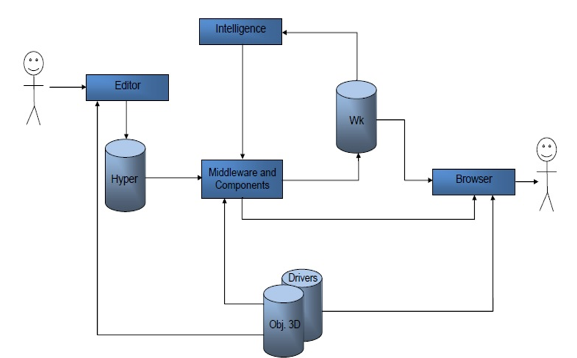
Figure 2 presents the architecture of the Toogle platform, proposed for implementing cyber-physical systems, which is based on the conceptual model presented. The platform allows to realize and monitor the physical world objects, and act in this. Its modules are described below.
Toogle Editor: Figure 3 shows a schematic of the Toogle's architecture, highlighting and expanding the editor module.
Fig. 3
Toogle Architecture – Editor
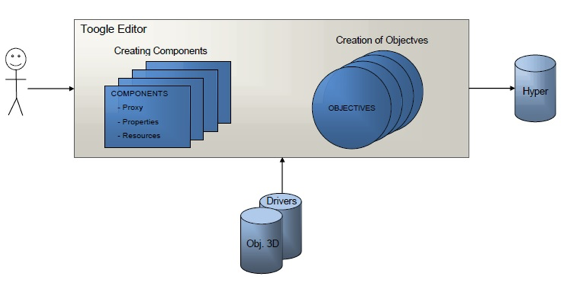
The Toogle Editor consists of web environment, which allows the user two basic operations for hyper-environments creating and editing:
As can be seen in figure 2, the module has access to a 3D object library and drivers for use with the properties and resources created. After the components and objectives are defined, the Editor module can forward the effective creation of the environment. For this, the components, properties, resources and objectives are described as a hyper-environment, which will be used by the Middleware and Component module in the effective creation of hyper-environment.
Middleware and Components: This module is responsible for providing access to different properties and resources of the components, through a messaging system. Once the services of recovery and modification of components information involve heterogeneous devices, the Middleware and Components module is tasked to become viable and practical communication between such equipment, providing abstraction to developers.
Figure 4 shows a schematic of the platform architecture, expanding the Middleware and Components module. After a hyper-environment be set in Toogle Editor, this module creates the existing components. Following are each of the entities involved in this module.
Fig. 4
Toogle Architecture - Middleware and Components.
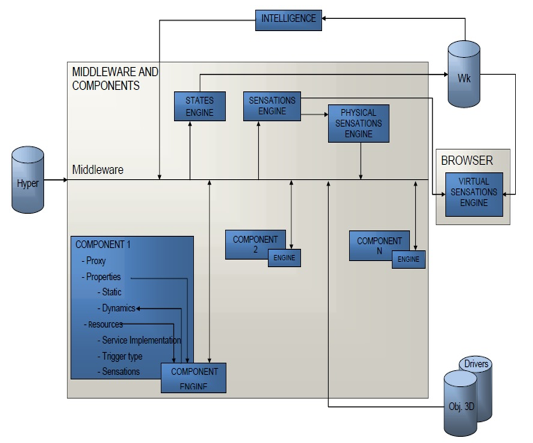
A component is composed of a proxy, properties and resources.
The properties are characteristics of the component and can be: static, when its value is constant; and dynamics, when their information is updated in some frequency by a resource.
Resources are actions that the component can perform, available to the hyper-environment to change its properties. Some features of the features are: service implementation, can implement/provide services for all components of the environment; trigger Type, can be fired by the platform or be continually realizing/monitoring an action that occurred in the physical world; sensations, can provide sensations to the user.
Regarding the availability of resources, the platform has a bank of resources with predefined implementations (drivers) that provide services. There is also in Toogle a bank of 3D objects that can be used with the properties of 3D representation of a component.
Every component has a Components Engine which basically has three functions: provide the properties of the component itself to the States Engine; update the dynamic properties of the component requesting resources in defined frequency; and implement and provide the resource through processes.
States Engine: is responsible for receiving the properties of all components and describe the hyper-environment in every moment of the world, creating the state in the current time.
Sensations Engine: receives requests of resources associated with the sensations and forwards it to one of responsible engines:
Physical Sensations Engine: responsible for handling resources that reproduce physical sensations in the environment, such as a feature that triggers an odor in the physical environment.
Virtual Sensations Engine: responsible for dealing with resources that reproduce virtual sensations, such as the presentation of a PDF file. This engine is present in the Browser module and will be described later.
Middleware: access to property and resources belonging to each component is made by a middleware that provides hardware abstraction, drivers for many devices, tools and libraries for messaging. The middleware is currently implemented by the ROS (Robot Operating System) [16]. The ROS is a framework for the development of robotic applications, which provides a messaging infrastructure (by requests/services or topics), drivers for different devices and a set of tools for robotics.
Intelligence of Environment: This module is responsible for providing different types of intelligence to the system. For a better understanding of this module, it is important here resume the concept of hyper-environment: one locus that has physical and virtual components and aims to achieve a set of objectives. As already mentioned, these goals are instances desirable for the properties of the existing components in hyper-environment.
The Toogle, through the Intelligence of Environment module (Figure 5), emerges as the system able to support the existence of these goals. This module takes advantage of the CPS description formalism to provide an ordered set of resources (actions) that will lead the hyper-environment the achievement of objectives.
Fig. 5
Toogle Architecture - Intelligence.
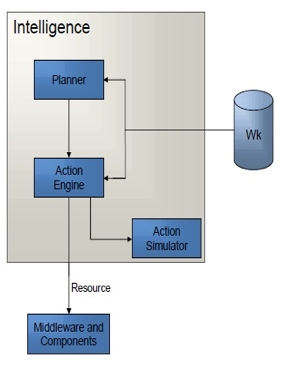
For such is used a planner that search, from the description of an initial state of the environment, arrive at a final state, which is defined by the objectives of the environment. For this, a set of actions (plays resources) are planned. The Action Engine checks the possibility of execution shooting of the planned features, shooting them in the Middleware and Components module in certain times (when the preconditions are met).
The Intelligence Toogle module aims to transform the description of hyper-environment made in Middleware and Components module, in a STRIPS formalization, planning actions, so that the objectives are met.
It is important to note that the formalization of cyber-physical environments through STRIPS can be directly related to the architecture proposed in this chapter. The properties of the components can be seen as the states of STRIPS approach (information about the world/environment). The existing resources in components work as the actions available in STRIPS. The Intelligence module also provides an Action Simulator to simulate the actions (resource execution) planned.
Toogle Browser: The Toogle Browser module (Figure 6) allows the user to interact with the hyper-environment through their sensations.
A Virtual Sensations Engine uses drivers from resources database that deal to provide different sensations for the user. There are drivers for representing properties of the components and drivers for resource presentation. Currently two drivers are implemented: Driver for 3D presentation, represents all hyper-environment components that have the property "3D Model" in their positions on a web virtual environment; and Driver to PDF file presentation, handles PDF presentation features that are fired/implemented in Middleware and Components module and displays to the user.
Fig. 6
Toogle Architecture – Browser.
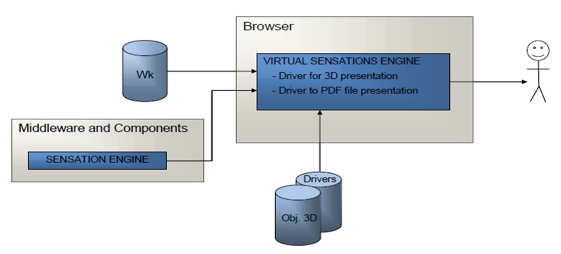
The browser module receives information from the state of world to represent, at each instant, the properties of the components, e.g., in the case of drivers for 3D presentation. Figure 7 shows the Toogle Browser running, through your driver for 3D presentation.
Fig. 7
Toogle Browser

In this work, the Toogle platform was developed in order to implement cyber-physical environments and has been applied, tested and validated in some case studies. Therefore, we propose a reflection in order to clearly define the approach outlined here: how, through the Toogle, you can implement an educational environment where physical and virtual aspects are modeled and integrated in order to contribute to the learning of subjects? The answer to this question is intended to be given below, relating the conceptual model for ECPS and Toogle platform. Each of the four modules of Toogle platform was responsible for implementing the engines of the conceptual model for ECPS, according to the following relationships:
The following is taken up each module of ECPS, relating the implementation engine to the Toogle platform.
Student and Context: All elements (students, teachers, learning objects, etc.) inside the ECPS, implemented by Toogle, are classified as components (associated with the virtual and/or physical space). Students and their contexts are formalized and abstracted in Middleware and Components module to be formed by components containing proxy, properties and resources. Students are also users in Toogle architecture, receiving information from sensations engines.
Teachers: Teachers are users operating in Toogle Editor to create the togle components (curriculum components) and set learning objectives. To provide a curriculum element, the teacher can choose a learning object of a database of components. To stipulate the learning objectives, you must perform the following procedures: the teacher indicates target values for properties of hyper-environment components, which will set a future state of the environment that aims to reach. In a example, the teacher could indicate a curricular component/content as a PDF file associated with a location of the physical world (such as a square, for example) and a learning objective as the component's visualization property must be true, so that the student has to view this component and their learning is possible.
Situation: The situations are implemented by the Middleware and Components module in Toogle, since they are formed by actions/resources existing in Toogle components. The States engine of Toogle is responsible for capturing and provide situations.
Affordance: The Affordance model is implemented by the Intelligence Toogle module. It is able to, from the student context (formalized by the Middleware and Components module) of your previous interactions and of established learning objectives, plan a number of possible situations so that we can reach a final state of desired learning. The Toogle Action engine is responsible for checking what resources (situations) should be fired to the student, from an established plan.
Interaction: The interactions are implemented in Toogle through the States and Sensations engines. From the capture of the state of the world by the states engine, Toogle provides interaction to the user through the browser, with your Sensations engine. This browser is capable of allowing to students and teachers, multi-modal experiences with physical and virtual learning objects of situations presented, e.g., through the drivers for 3D presentations, of the Virtual Sensations engine.
Learning Objectives: Through Toogle Editor, it is possible the teacher to determine the learning objectives. Once established in the Editor, the objectives are formalized in the Middleware and Components module and can be used by Affordance model.
Curriculum Components: are implemented by Toogle components in the Middleware and Components module and their creations and edits are made by Toogle Editor.
In order to test and validate the approach outlined here, we developed a case study is intended to evaluate the proposal of Educational Cyber Physical Systems (ECPS) and its ability to integrate networks of sensors and actuators in order to provide different levels of interaction real-virtual in learning situations.
The following shows the description of the development of a ECPS to the case study described below, from two perspectives, analyzing first the modules of Toogle platform and then the suggested model for ECPS:
“A teacher wants to create a class on a subject, using physical and virtual content. For this he want to use two booklets (pdf files), relating them to geographical locations, such as libraries, parks, squares, recreational areas, etc. The objective of learning, the teacher wants students to receive and view such handouts, the first of which is a prerequisite for the second, or the student can only receive the second after the first visualized.”
The development of ECPS got its start by creating the environment components. Figure 8 presents a schematic of the architecture Toogle centered in the editor modules, and instantiated for the case study. In the figure, you can see that the teacher acts in Toogle editor, through the creations of the components that will be part of hyper-environments and learning objectives. You can also check that 3D objects and drivers are available from platform to use in the creation stage. For this case study were made available three 3D objects: 3D model of the building of the Computer Science Center of the X University; 3D model of a library, downloaded from a database of 3D objects present on the Internet [2]; 3D model of a person (Avatar), downloaded from a database of 3D objects present on the Internet [2]. Also available were two drivers, ProvideLocation, implementation that provides location from the GPS data of a Smartphone or Tablet device and SendPDF, implementation that sends a PDF file to a component through the virtual sensations engine when the localization properties of the components are the same. In sequence shows details of this component creation step.
Fig. 8
Architecture Toogle Editor – Case Study
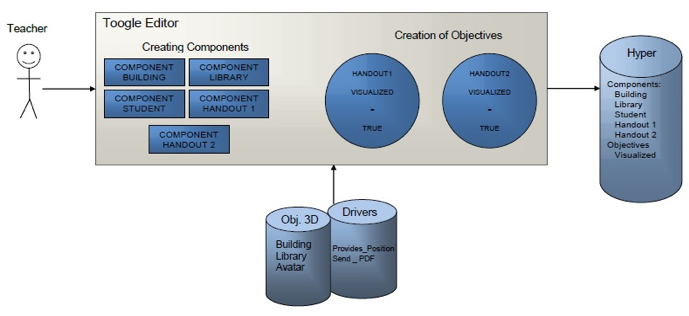
Each component of ECPS was designed using the Toogle Editor. The properties and resources were established for each component. Each property of a component can be associated with a constant value (assigned directly in the editor) or a feature of some component or driver Toogle (dynamic property). In the case of this second option, this feature (or driver) selected will be responsible for constantly updating the value of this property (through the engine components). For example, the property "Location" Student component is dynamic and was associated with the resource "ProvideLocation" the "smartphone" device, making the location of the student is always being updated by the student smartphone GPS data.
For the case study of the learning context, associated with a "Location" property of the component "Apostila1" to the classroom used for the tests, while the "Location" component "Apostila2" was associated with the library. For these two components was also created a resource of type "SendPDF", which was chosen the implemented Driver Library and available on ECPS. This feature was implemented to send a PDF file to a student through the virtual sensations engine, when the actions engine indicate your shot. The actions engine, in turn, is checking the pre-firing conditions, in this case, if the location properties are equal. The idea is that when the property "Location" Student is equal to property "Location" of "Apostila1", the PDF file associated with the "Apostila1" component, is sent to the student, through virtual sensations engine. The Toogle Editor also enables the learning objectives are set from the specification of some components of the environment properties. Thus, it was established as learning objectives that the properties "displayed" components "Apostila1" and "Apostila2" are "true". Note that the feature "SendPDF" modifies the "Viewed" property of a component when the PDF file is sent / received.
After all components have been inserted into the Toogle Editor, the creation and formalization of the environment occurred. The description of the components, their properties and features, plus the characterization of objectives, produced the hyper-environments (an XML file containing all information in an organized way). By the time the hyper-environments was finalized (generation of the XML file), the Middleware and Components modules created in fact all components on the platform, being, from that, responsible for all communication components. This was done through existing resources in each component, implemented through ROS topics and services. For example, the Component Engine of the Component Student, went on to update the property "Position" through the driver "ProvideLocation".
Finally, the intelligence modules, through the Planner, planned actions (resource play) so that the environment to reach the future state from the initial state. After this planning be done, this actions engine present at the modules began to constantly checks the possibility of implementation of the planned features.
Navigating the ECPS (Toogle Browser Modules): Finally, after the components have been created and formalized for the case study, the student could navigate the hyper-environments through the Toogle Browser. Figure 9 shows a schematic of the navigation.
Fig. 9
Architecture Toogle Browser - Case Study
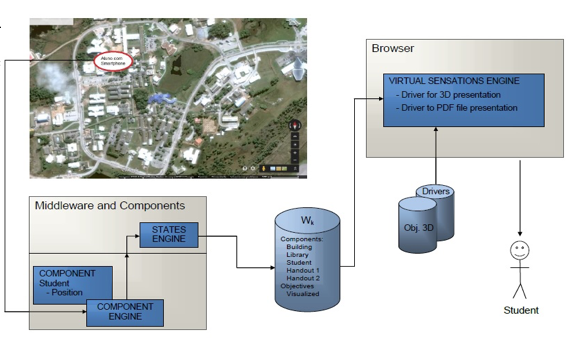
All information of the components are stored and constantly updated in hyper-environments in an XML file, the states engine. This file, which is the world's state at each time, is read by the driver for 3D browser presentation, and the components that possess 3D representation and location property are displayed in a web virtual environment. In the case study presented here, once the student moved by the physical world, was perceived by the Middleware and Components Toogle modules, through your Smartphone, states engine generated hyper-environments in time current with the properties of all components. The property position of the student, for example, has been updated by GPS data from your Smartphone (next to the building of Computer Science Center). Thus, the Navigator modules read the hyper-environments information stream and through the 3D display driver, the Avatar student appeared at the corresponding location (Figure 10).
Fig. 10
Toogle Browser (3D presentation) - Case Study
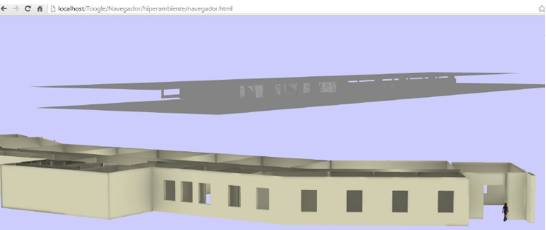
Learning objects (Apostila1 and Apostila2) were presented when the student entered into the corresponding sites to their locations (classroom and library), since the actions engine of Intelligence modules, found that the actions planned shooting conditions had been met. Figure 11 illustrates the scenario of the student obtaining the display Apostila1 learning object, the measure that he entered the classroom.
Fig. 11
Toogle Browser (PDF presentation) - Case Study
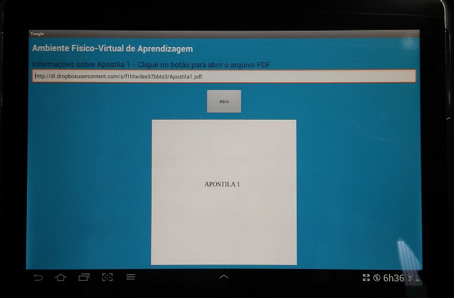
This paper explores the concept of Educational Cyber Physical Systems, which seeks to integrate physical environments with virtual learning environments. The results of the work are very important, since consolidate a proposal/too innovativel, which seeks to include physical and virtual resources for creating learning spaces. The identification of elements making up the physical and virtual learning environments, through a conceptual model, is characterized as the main contribution of this work, as well as a tool proposed for implementation. This work adopted the term ECPS through its conceptual model and features and proposed the Toogle tool for implementation. The development of Toogle as an integrating tool for creating ECPS requires a great deal of programming, which led to a first version of the tool, able to provide even limited and easy resources to develop ECPS. Currently, new drivers for virtual sensations are being developed as well as expands the resource library and improves the aspects of system interface. A new version of the tool is already in the short term future work of this work.
1. Universidade Federal do Rio Grande, RS, Brasil. E-mail: rafaelpenna@furg.br
2. Universidade Federal do Rio Grande, RS, Brasil. E-mail: sam.devincenzi@gmail.com
3. Universidade Federal do Rio Grande, RS, Brasil. E-mail: silviacb@furg.br
4. Universidade Federal do Rio Grande, RS, Brasil. E-mail: marcosamaralrg@gmail.com